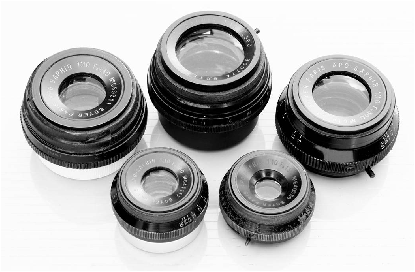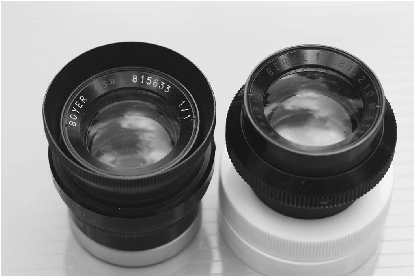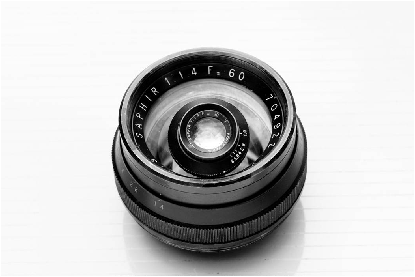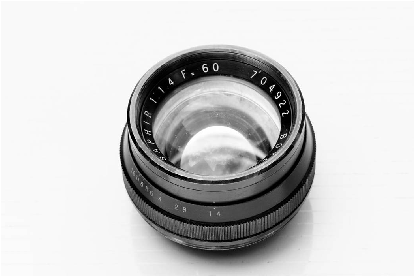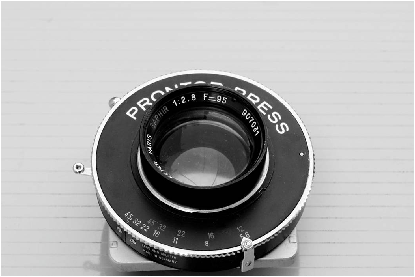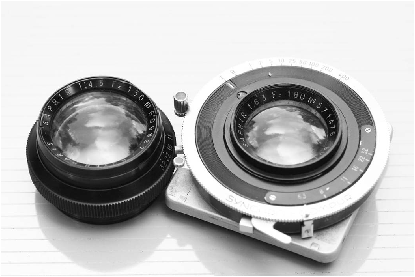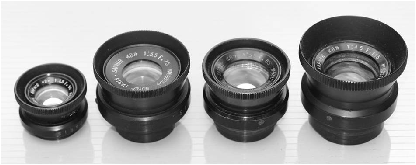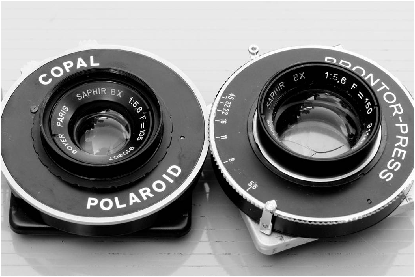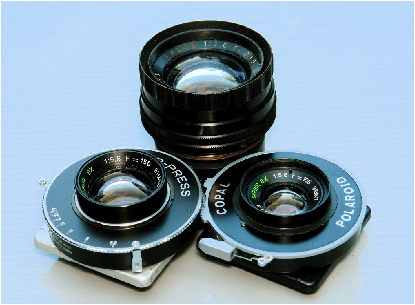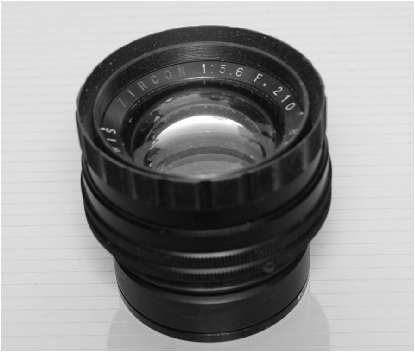|
|
|||||||||||||||||||||||||||
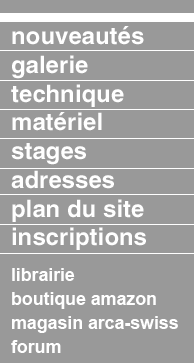
the authors
|
Optiques Boyer: A short history of the company with an incomplete catalog of its lenses.Dan Fromm (USA) & Eric Beltrando (France)September, 2008Abstract Établissements Boyer, 25, Bvd Arago, Paris 13ème, France produced a wide range of photographic objectives. This note reports on them.
Company HistoryDaniel Fromm (DF) and Eric Beltrando (EB) are deeply indebted to Isabelle Lévy, a granddaughter of André Lévy and Suzanne Lévy-Bloch, for information on the firm’s history.
Mme. Lévy tells us that Établissements Boyer was founded in 1895 by Antoine Boyer. The firm made lenses and was initially very small, with only four employees. When Antoine Boyer was succeeded by his sons André and Marcel, the firm’s name changed to Boyer Frères. By this time the firm had grown to six employees. After André Boyer’s death in 1925 Marcel Boyer was unwilling to manage the firm by himself, so sold it to Mme. Lévy’s grandparents. André Lévy (1890-1965) was the son of Abraham Lévy, an optician in Orléans. André worked for the commercial side of Lacour-Berthiot before 1914 and at the time he bought Boyer worked for Baille-Lemaire as director of the photographic department. Suzanne Lévy-Bloch (1894-1974) was the daughter of Paul Bloch, an Alsatian architect who established himself in Paris in 1871 [1]. She graduated in mathematics and was ingénieur de l'Ecole Supérieure d'Optique et de l'Institut d'Optique Théorique et Appliquée; her teacher was Henri Chrétien [2]. From 1925 until her husband’s death in 1965, she was Boyer’s only designer. Her granddaughter Isabelle believes that she was among the first, may have been the very first, female optical engineers in France. Isabelle Lévy reports that her grandparents acted as one. Her grandfather was the entrepreneur, her grandmother the mathematical prodigy, concerned with little but the equations she had in mind. After André Lévy died, management of the firm passed to his eldest son Robert. Mme. Lévy-Bloch went into a hospital where she stayed until her death. Boyer failed in 1970, perhaps, like so many other European firms in the photographic equipment industry that failed in the ‘60s and ‘70s, because of technical and economic conditions. Robert Lévy may not have been the manager the firm needed, but given the general collapse of the industry this is far from certain. After the firm closed it was acquired by CEDIS, owned by M. Kiritsis and the former owner of Roussel, another French company in optics which had been closed a few years before. Production resumed under the brand name CEDIS-Boyer. CEDIS-Boyer, as described by EB, was quite a small firm that did lens design and final assembly, with all of the components but barrels bought in. Production of lens elements was subcontracted to former employees. The firm closed for the last time in 1982 after M. Kiritsis died. Collecting available information on Boyer lensesBoyer’s lenses, excepting the meniscus lens fitted to many models of Photax cameras, are uncommon, poorly documented, and little-known. The most common multi-element Boyer lenses are Topaz, triplets used as taking lenses, which are often offered on eBay.fr, usually on inexpensive old French cameras. Tessar type Saphir taking lenses also turn up on old French cameras. Tessar type Saphir, Saphir B, and Topaz lenses sold for enlarging are not terribly rare on eBay.fr. Apo Saphirs are offered very occasionally on eBay and on vendors’ web sites. Beryls turn up too, but less often. The others are completely unheard-of. A search on usenet found references to Saphir, Apo Saphir, Beryl, and Topaz; of these nearly all were to Tessar type Saphirs sold as enlarging lenses. The information presented here comes from a variety of sources. The most important sources for post-WWII lenses are Boyer data sheets that EB retained and EB’s memories of CEDIS-Boyer. EB came to CEDIS-Boyer as a dissatisfied customer – his Saphir B enlarging lens did not meet his expectations – became friends with the principals and eventually did optical calculations and tested lenses for them. Before becoming acquainted with EB, DF took information from a variety of sources, many of them contradicted by others and, most importantly, by EB. For pre-1939 lenses, we rely on EB’s information and some Boyer propaganda that DF found. The lists of lenses by name, design type, focal length, and maximum aperture presented below were taken from CEDIS-Boyer fiches techniques, Rolyn data sheets, and pre-1939 Boyer catalogs. Rolyn was Boyer’s US distributor. They are incomplete. DF has found A Lens Collector’s Vade Mecum, a somewhat unreliable and incomplete catalogue raisonné of lenses, very useful as a guide to purchasing old lenses. Unfortunately, much of the scant information that the VM offers on Boyer lenses is incorrect. Chronology? There is little data from which to construct a table
linking Boyer lenses’ serial numbers to dates of manufacture. The
earliest date DF has been able to find for a camera bearing a Boyer
lens is 1924. The earliest post-WWII Boyer lens DF has seen is a
50/3.5 Saphir s/n 250787 on a 1946 Cornu Ontobloc I shown on Jacques
Charrat’s site http://clicclac.free.fr. Gerard Langlois’ site
http://glangl1.free.fr/ shows a Kinax II with 100/4.5 Saphir serial
number 276185, says the camera was in production from 1946-1950. P-H Pont gives a Boyer chronology in the third edition of his little book Les Chiffres Clés. He believes that serial number 700,000 was used around 1958. This is not consistent with DF’s 240/10 Apo Saphir s/n 689511, whose quality control ticket is dated October, 1964. Note that not all Boyer lenses have serial numbers. EB notes that “in general, those intended to be distributed by an independent brand or to be buried in equipment like photocopiers (Beryl <<S>>) or microfilm readers (15/1.4 Saphirs), or for some other reason. A series of Saphir BX wasn’t given serial numbers because the trim rings were delivered late by the engraver. It is, therefore, risky to use serial numbers to estimate production volumes. Moreover, Boyer subcontracted for other makers (sometimes prestigious …) and even sold lens elements to be mounted into other makes’ lenses.” The meniscus taking lenses used on, e.g., Photax cameras, all seem to lack them. So do some Topaz taking lenses and projection lenses. DF’s 20/1.9 Saphir also has no serial number. Boyer made more multi-element lenses than the serial numbers used indicate. The coated 50/3.5 Saphir mentioned above suggests that Boyer began coating their lenses in 1947. But EB reminds us that Boyer coated older lenses originally sold uncoated. He also remarks that until Boyer bought a coating chamber sometime in the mid-1970s they sent lens elements out, usually to SOM, to be coated. The sketchy information we have on dates that can be tied to serial numbers indicates that Boyer used, in very round numbers, approximately 14,000 serial numbers annually from 1924-5 through 1939, 25,000 or so from 1946 to 1960, roughly 21,000 annually from 1960 through 1964, and perhaps 12,000 annually from 1964 to the firm’s end in 1982. EB relates that in the 1970s CEDIS-Boyer’s production was semi-artisanal, with all components but barrels bought in with final assembly by hand on CEDIS’s own premises. Henri Gaud commented that “Boyer’s production was low after the war” in a discussion “bague de serrage copal” http://www.galerie-photo.org/n-f-23760.html on galerie-photo.info. Small, perhaps, in comparison with, e.g., Rodenstock, Schneider, and Zeiss, but comparable to, e.g., Dallmeyer, Ross, Taylor Hobson, and Wray. Boyer seems to have made more lenses than some other French lens makers, e.g., Angenieux and Kinoptic. Nearly all of the lens types that Boyer sold from 1970 onwards were first designed before 1939. The new post-WWII types included an f/1.0 Saphir, which was one of the two lens designs that Boyer patented, the Saphir BX/Zircon, and the Apo Zircon. Boyer never developed modern wide angle lenses for large format cameras and made very few telephoto lenses. Taking lens or enlarging lens? Boyer sold Topaz and Tessar type Saphir lenses as taking lenses and as enlarging lenses. In addition, they sold plasmat type Saphir B and BX lenses exclusively as enlarging lenses. A Rolyn Optics sales brochure asserts that “Boyer are the first optical manufacturers to mass-produce lenses specially computed for photographic enlarging,” so DF found it reasonable to expect lenses Boyer sold for enlarging to perform poorly as taking lenses at distance. EB, however, reports that between 1935 and 1960 only special objectives, usually with name ending in “-B,” were specially computed for enlarging. In the Topaz and Tessar type Saphir lines taking and enlarging lenses were identical; Saphir BX lenses are identical to Zircon taking lenses. Only Saphir Bs were computed especially for enlarging; EB says they were optimized for 5x enlargements and were intended to be used at f/11. In the Beryl line, reprographic lenses, including the Emeraude, and taking lenses are identical. Which Boyer lenses in barrel will go directly into shutter? On the one hand, EB’s fiches techniques indicate that the cells of nearly all of the lenses Boyer produced in the 1970s will go directly into standard shutters, e.g., Compur 00, 0, 1, 3, or 5FS. On the other, DF has Boyer lenses that the fiches techniques say will go into shutter and that won’t. This, according to EB, because Boyer was very flexible in meeting customers’ requirements. The chances that a Beryl, Saphir BX, or Zircon (except the 360/7.7) will go directly into shutter are good. For other Boyer lenses in barrel, the only way to find out whether the lens’ cells will go directly into shutter is to try. Boyer has long been out of business but their former US distributor Rolyn Optics, of Covina, CA, still has some new Boyer lenses in stock. In February 2006 Rolyn offered DF some Apo Saphirs, f/2.8 Saphirs, and Zircons, all in barrel, at their 1982 list prices. The prices quoted were far out of his range and considerably above market prices for comparable used lenses in good condition. To give an idea of how far Rolyn’s offer was above market prices for used Boyer lenses, since receiving it DF bought 95/2.8 Saphir, 105/5.6 and 150/5.6 Saphir BX, all in near-new condition for 5% of Rolyn’s prices for their new old stock. Also an as-new 300/10 Apo Saphir for 10% of Rolyn’s price. Plus 135/10 Apo Saphir and a 210/6.8 Beryl, both well worn, for pennies and a 240/10 Apo Saphir in good order for 15% of Rolyn’s price. DF and EB both use Boyer lenses. Used Boyer lenses often sell for much less than comparable used lenses from other makers. Because of their quality, availability, and relatively low prices Apo Saphirs; Beryls; tessar type Saphirs, especially the f/6.3; Saphir BXs; and Zircons are still attractive to large format, including 6x9, photographers. Annotated list of Boyer lens types, in alphabetical order:
H. Gaud reports that his 600/10 “easily bears comparison with a T-ED and a Fuji C, the T-ED is a little sharper but covers much less, the Fuji C is equal, a little cooler, but covers more . ” This is high praise. DF has 135/10, serial number ; 180/10, s/n 641117; 240/10 s/n 689511; 300/10, s/n 614259; and 360/10, s/n 800774. All shoot very well at all distances, are best at f/16. He has two other fine ~300 mm process lenses, a pair of dialyte type 305/9 Apo Nikkors. Both are marginally better at distance, especially at apertures larger than f/16, than his 300 Apo Saphir. There is supposed to be only one correct position for a lens’ diaphragm. Heliar types have two possible locations, in front of or behind the central singlet; typical diagrams for Heliar types place the diaphragm behind the singlet. In Apo Saphirs 614259, 689511, and 641117, the diaphragm is in the conventional position, i.e., behind the singlet. 800774’s diaphragm and name plate, however, are in front of the central singlet and the lens shoots very well at ~ 200 m mounted that way. It shoots marginally, perhaps not really, worse at distance mounted reversed, which is not a surprise for a strictly symmetrical lens design. EB adds that the 2500/12.5 Apo Saphir “ was built for the military. It was used, among other purposes, for filming nuclear tests (whence the front cover) and one is (was ?) used for wide field photography at the Meudon astronomical observatory. This should give those acquainted with astronomers’ demands for quality an idea of how well corrected the lenses are.”
Claimed coverage at f/22, 85º. But Rolyn’s documentation describes a version of the Beryl intended for reprographic work that covers approximately 75º at unspecified aperture. Reprographic Beryls were offered in all Beryl focal lengths up to 250 mm in mounts with “an enlarged iris driving ring identical to that of the Saphir B.” EB suggests that Boyer’s and Rolyn’s coverage estimates are overstated and that in practice one should not count on more than 70º in general use, 50º in exacting, e.g., reprographic, applications. His advice brings to mind discussions of Goerz Dagors’ coverage on photography bulletin boards; there’s no consensus and frequent complaints that the lenses cover less than 85º. EB reports that, mounting aside, reprographic Beryls (Emeraudes) are identical to and perform exactly like plain Beryls. DF has seen 210/6.8 Beryls at an on-line vendor and on eBay whose diaphragm control rings flare out like a lens hood or blunderbuss; EB adds ‘ The lens mount is so-called “recessed” for enlarger use; originally without illumination of the f-stop scale; the f-stops are not equidistant.’ DF’s Saphir Bs and Beryl S are similar. Henri Gaud’s comment “old blunderbusses” quoted below is apt, at least when speaking about their shape. Reports on Beryls’ performance posted on www.galerie-photo.info have been mixed. H. Gaud has characterized them as “bottles’ bottoms” but others, including DF and EB, are happy with them. M. Gaud has since said “As for Berthiot’s (sic) old blunderbusses only the ApoSaphirs find grace in my eyes, but without the least denigration [of the others.]” DF has a 210/6.8 Beryl, s/n 638649, in straight barrel whose cells will go into a #1 shutter; it was removed from a Gestetner copy machine. A good usable lens, but DF believes that his 210/7.7 Beryl S shoots a little better.
DF has an f/7.7 6/2 Dagor type Boyer lens, s/n 815633, engraved only “<< S >> 1/1” that seems to be a 210/7.7 Beryl S. In spite of the indication that it is optimized for 1:1, it shoots very well at distance but is best used at apertures of f/16 and smaller. The front section of its barrel is flared out like a lens hood. No focus shift on stopping down. DF’s 210/9 Konica Hexanon GRII is slightly sharper at larger apertures, also slightly less contrasty at all apertures; both are fine lenses, one could be happy with either.
Philippe Cas kindly lent his 210/6.8 Emeraude, s/n 783276, to DF. It shoots as well at distance as DF’s 210/6.8 Beryl and 210/7.7 Beryl S.
EB remarks that the Opale’s soft focus effect was obtained by chromatic aberration, and only by that. The Opal is a completely standard Tessar type Saphir, except that the rear group has an element of the same index of refraction as usual but with different dispersion. If one focuses it with a particular color, e.g., yellow, the image will be perfect for that color but focus will be shifted for the other colors, whence a notable “envelope.” In black and white, the results depends on the film (orthochromatic or panchromatic, the soft focus effect being greater with the latter), the filters used, and the quality of the light (natural or artificial). With panchromatic film in 4x5 inch format and natural light, his 300 Opale has given EB some really lovely portraits. He has used his 135 Opale on 35 mm; it was soft, with very strong diffusion. In color, the results are unattractive, with violet halos around clear zones. However, the coverage is good, with neither distortion nor astigmatism. Opales are quite unlike anachromatic lenses of the Puyo type. The impossibility of using Opales for color work led to the formula’s abandonment.
EB reports “Wide angle lens replaced in the catalog by the Beryl recalculated in the 60s. To my knowledge, no Perles were ever coated .” He has a 100 that, he says, easily covers 5x7 at small apertures.
We say below that f/1.9 and f/2.8 Saphirs are 6/4 double Gauss types. This seems to be true for lenses made after 1945, but EB reports on pre-1939 designs of other types at these speeds on www.dioptrique.info .
f/1.4 Saphirs include two design families. Or perhaps there are systematic errors in the fiches techniques. Internodal distance[4] is less than -2% of focal length for the 20, 25, and 35 but is around -20.5% for the 40, 50, and 100. So the short ones are more-or-less normal and the longer ones are somewhat telephoto. The fiches techniques give internodal distances for only these focal lengths.
DF has had a 60/1.4, s/n 704922, that was offered on eBay as an enlarging lens and has seen large Durst enlargers on eBay with a 60/1.4 Saphir included. It may have been intended for high speed printing. He was unable to use it on any of his cameras because of its short back focus. Vivek Iyer, who has it now, reports that it is flary, not very sharp wide open, and distorts badly. To which EB adds: As for the 1.4 Saphir, I completely confirm what Vivek Iyer said. I add that the lens was recalculated at least three times, once in the ‘70s. I have a coated 100 mm prototype with diaphragm in aluminum barrel. It weighs nearly 1.4 kg. I use it in astrophotography. It covers 6x7. Stopped to f/2.8 it is excellent, but with severe distortion. It also has significant curvature of field. Not up to contemporary Japanese lenses, but it had the merit of having been made in many focal lengths.
The f/1.9 Saphirs also seem to include two design families. According to data in the fiches techniques, 15 – 100 mm have back focus[3]/focal length around 0.74, the 110, 125, and 200 range from 0.97 to 1.02. DF has a 20/1.9 with no serial number in M19x0.5 that came with a variable-length adapter to C-mount. He believes it had been used on a video camera. On its adapter it gives magnifications of 2:1 to 3:1. Wide open it put an unsharp image on a Beaulieu cine camera’s ground glass; image quality is worse at smaller apertures. Not surprising, it should have been reversed for use at magnifications above 1:1. EB regards the f/1.9 Saphirs as much better than the f/1.4s, uses a 75/1.9 for infrared photography on 24x36 with excellent results.
DF has a 95/2.8, s/n 907031. It is in M39x1, which may explain the seller’s assertion that it is an enlarging lens. Its cells screw directly into a #1 shutter and spacing is correct. It covers 6x9 at infinity; subject to a retest to check for operator error in the first trial, it seems much less sharp than DF’s 4”/2.0 Taylor Hobson, especially at large apertures. EB also has a 95/2.8, finds that it does not cover 6x9 at infinity.
EB adds that there were still other Tessar type Saphirs, including some with maximum aperture of f/8 and an infrared lens used for aerial photography. EB’s calculated performance for 1934 and 1947 100/4.5 Saphirs as
shown on Rolyn’s price lists and the fiches techniques show no 75/3.5 Saphir. DF has, however, seen a 75/3.5 Saphir in barrel, s/n 790069, offered on eBay.fr. The lens’ engravings were clearly visible in the listing; “Saphir,” not “Saphir << B >>” as is usual with Saphir Bs. It has a straight, not a flared, diaphragm control. DF has a 150/4.5 Tessar type Saphir, s/n 606827. It shoots acceptably at near (~ 5m) and far (~ 200 m) distances. Rolyn’s f/4.5 Saphir data sheet and the fiches techniques say that it should be threaded M39x1 at the rear; but is in fact threaded M45x1. DF also has a 210/6.3 Tessar type Saphir, s/n 563262, that came in a bundle with a 300 Apo Saphir. Its diaphragm is locked at f/8 so he has not tried to use it. EB regards the f/6.3 Saphirs as the best of the Tessar types, has a 270 that “is excellent wide open”.
DF has four Saphir Bs: 50/3.5, s/n 601434; 75/3.5, s/n 698656; 85/3.5, s/n 632189; and 135/4.5, s/n 632740. All four have diaphragm control rings in the form of a blunderbuss, but some of the Saphir Bs listed on eBay.fr, e.g. 110/4.5 s/n 611643 and 75/3.5 s/n 809739, have had straight diaphragm control rings. DF has used his 75 for closeup work at magnifications below 1:1; it shoots well in that application at small apertures. His 135 is not as good close up as his 135/5.6 Wollensak Enlarging Pro Raptar, also a 6/4 plasmat, and shoots quite poorly at distance. These results are not surprising; when EB complained to CEDIS-Boyer about his Saphir B’s poor performance, he was told that they are optimized for 5x enlarging and are intended to be used at f/11.
Data in the fiches techniques indicate that Saphir BXs have the same back focus, inter-nodal distance, and angle of view as Zircons. We believe that BXs are simply Zircons in barrel badged and sold as enlarging lenses. DF has and shoots BX 105/5.6 s/n 910907 and 150/5.6 s/n 911405 at distance; they are good taking lenses.
EB comments “The firm’s war horse! Hundreds were still being sold monthly when the firm was brutally closed. They were very well made, but like all triplets, with pronounced curvature of field, and spherical aberration wide open. The f/2.9 series before 1939 is perfect as a portrait lens: smooth without being soft. As far as I know it is the basis of the Rubis (very few sold). Many were also sold as enlarging lenses, in spite of their middling quality in that application.”
P. Filliquet – see www.galerie-photo.com/pierre-filliquet-paysage.html - uses a 305 Zircon in Copal #3 as a taking lens on 8x10. He works to a high standard. DF has a 210/5.6, s/n 803909, whose front cell has numerous cleaning marks including a monstrous circular gouge. Damaged front element notwithstanding, it shoots approximately as well on 2x3 as a 210/7.7 Beryl S. EB has a similarly damaged 210 that he uses on 4x5, reports that it “is perfect in spite of a bubble in the very middle of the front element!” References
For further information, we recommend Eric Beltrando’s web site Acknowledgement: the authors are very grateful to Charles Barringer for taking pictures of Dan Fromm’s lenses.
Dernière modification : 2008
|
||||||||||||||||||||||||||
|
|||||||||||||||||||||||||||





